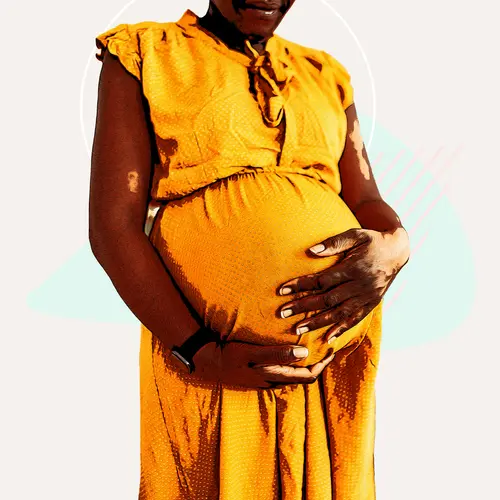Usually, your uterus tips forward at the cervix (a cylinder-shaped neck of tissue that connects the vagina and uterus). A tilted or tipped uterus tips backward instead of forward. It’s a fairly common difference in how a uterus is positioned.
What Does Tilted Uterus Mean?
In most cases, your uterus lies horizontally over your bladder, pointing toward your belly. But a tilted uterus angles back toward your rectum. About 1 in 4 people with a uterus have one that’s tilted this way.
What are the symptoms of a tilted uterus?
A tilted uterus doesn’t usually cause problems. But some people may notice such symptoms as:
Pain during sex. Due to the tilted position, your partner can easily bump your uterus and even your ovaries during penetrative sex, causing discomfort. This can be especially painful in sex positions where the person with a tilted uterus is on top.
Tearing. During rough sex, it’s possible to tear nearby ligaments — the tough strips of connective tissue surrounding the uterus — which may need medical care.
Menstrual pain. If you have a tilted uterus, your period might hurt more than usual, especially if you have a related condition, such as endometriosis.
Other common symptoms of a tilted uterus include:
- Trouble controlling your bladder (urine leakage or urinary incontinence)
- Urinary tract infections (UTIs)
- Pain or discomfort while wearing tampons
What Causes a Tilted Uterus?
A wide range of reasons could lead your uterus to tilt backward. Some causes include:
- Menopause. As you age, the ligaments holding your uterus can weaken, resulting in a backward tilt.
- Adhesions.Pelvic surgery can cause a band of scar tissue to form, which can pull the uterus into a tilted position.
- Endometriosis.It is a medical condition where cells that usually grow inside the uterus are found growing outside the uterus. The cells can “glue” the uterus to other organs, causing it to tilt.
- Fibroids.Fibroids are noncancerous tumors that can cause your uterus to tilt backward.
- Genetics. A tilted uterus may have a genetic link, and the condition may run in your family.
Can I Get Pregnant With a Tilted Uterus?
Some people worry that having a tilted uterus will hurt their chances of becoming pregnant. Whether your uterus tilts forward or backward, it does not affect your chances of conceiving or carrying a baby. In fact, pregnancy might even cause your uterus to tilt backward.
How Is a Tilted Uterus Diagnosed?
To check if your uterus is tilted, your doctor will do a pelvic exam. That's when they examine all your reproductive organs, including your vulva, vagina, cervix, ovaries, uterus, rectum, and pelvis.
The doctor will put two fingers into your vagina and push the cervix. With their other hand, they’ll press down on your abdomen to gently feel your uterus in both hands. This way, they can check the size and position of your uterus and check for abnormal growths.
What Are the Treatment Options for a Tilted Uterus?
Everyone’s body is unique. Your doctor can help you find the best treatment option for you if you’re having bothersome symptoms. If you’re not having any symptoms, you don’t need to do anything. Some of the most common options include:
Hormone therapy. Hormone therapy lowers the estrogen hormones in your body. Lowering estrogen hormones helps lessen pain and treat symptoms of underlying conditions (such as endometriosis). The most common form of hormone therapy is birth control in the form of patches, pills, or rings.
Pessary. To help the uterus stay propped forward, your doctor may insert a plastic device. This could be done temporarily or permanently. The drawback of using a pessary is that there may be a risk of infection or inflammation. With a pessary, you may still experience pain during sex, and the plastic device may also cause your partner discomfort during sex.
Surgery. During surgery, the uterus can be repositioned to sit above the bladder. In some cases, your doctor may recommend complete removal of your uterus (known as a hysterectomy). Surgery is straightforward and usually very successful.
Exercises for a Tilted Uterus
In some cases, a doctor may be able to change the position of the uterus during a pelvic exam by hand, and practicing pelvic exercises might keep it in place. For example, exercises such as Kegels — where you tighten your muscles as if trying not to pee — might help if you have a tilted uterus.
But there is no strong evidence suggesting that any exercises can shift a tilted uterus. In many cases, even after the uterus is moved, it eventually tips backward again.
Tilted Uterus FAQs
Can a tilted uterus cause back pain?
Yes, having a tilted uterus can cause back pain. For example, one study found that people with a tilted uterus were more likely to experience lower back pain in the first half of their pregnancy.
Is childbirth harder with a tilted uterus?
In the majority of cases, no. Having a tilted uterus won’t make it harder for you to give birth.



